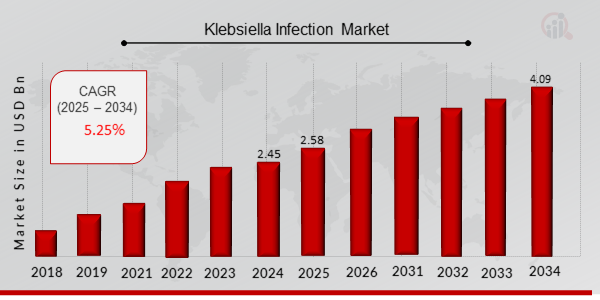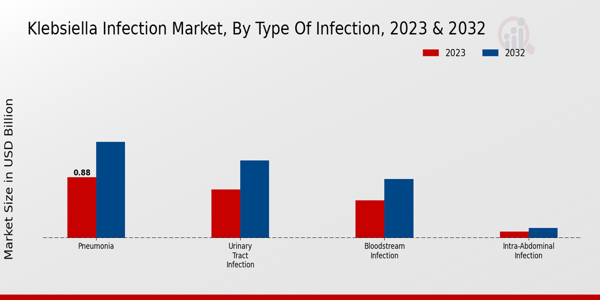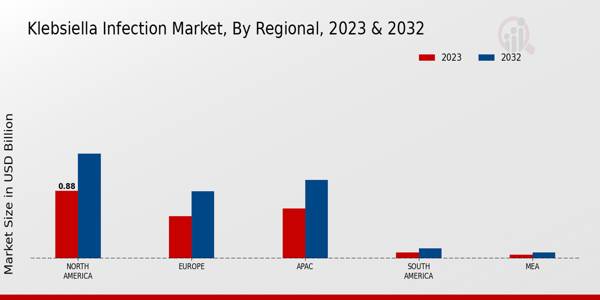Klebsiella Infection Market Overview
As per MRFR analysis, the Klebsiella Infection Market Size was estimated at 2.45 (USD Billion) in 2024. The Klebsiella Infection Market Industry is expected to grow from 2.58 (USD Billion) in 2025 to 4.09 (USD Billion) till 2034, at a CAGR (growth rate) is expected to be around 5.25% during the forecast period (2025 - 2034).
Key Klebsiella Infection Market Trends Highlighted
The Klebsiella Infection Market is primarily driven by the increasing incidence of hospital-acquired infections and the rising prevalence of antibiotic-resistant strains. Healthcare facilities are facing challenges with the management of infections caused by Klebsiella, which often lead to significant morbidity and mortality. Furthermore, the growing awareness among patients and healthcare professionals regarding infection control measures contributes to the demand for effective treatment options. Advances in diagnostic technologies also play a critical role, enabling faster identification of infections and supporting timely interventions. There are numerous opportunities to be explored in this market, particularly in the development of novel therapies and vaccines targeting Klebsiella infections. The rise in investment in research and development activities, especially in biotechnology and antimicrobial stewardship programs, presents a pathway for innovation. Additionally, expanding healthcare infrastructure in developing regions offers a chance for companies to introduce new products and services tailored to local needs. Collaborations between academic and pharmaceutical entities can result in breakthrough therapies that address the challenges posed by resistant strains. Recent trends indicate a shift towards personalized medicine and the use of precision therapies in managing Klebsiella infections.Increasingly, tailored treatment plans based on individual patient profiles and specific bacterial resistance patterns are gaining traction. There is also a growing focus on the integration of technology with healthcare, utilizing digital health solutions to enhance the monitoring and management of infections. Enhanced infection control protocols and educational initiatives in healthcare facilities are becoming common practice, reflecting a proactive approach to mitigate the impact of Klebsiella infections. Such trends are expected to transform the landscape of infection management, aligning with global health priorities.

Source: Primary Research, Secondary Research, MRFR Database and Analyst Review
Klebsiella Infection Market Drivers
Rising Incidence of Hospital-Acquired Infections
The Klebsiella Infection Market Industry is witnessing significant growth driven by the increasing incidence of hospital-acquired infections (HAIs). HAIs, including those caused by Klebsiella pneumoniae, are a major concern in healthcare settings worldwide. Factors contributing to this rise include prolonged hospital stays, the increase in surgical procedures, and the prevalence of immunocompromised patients. Infections caused by Klebsiella are usually associated with high morbidity and mortality rates, particularly in critically ill patients.Enhanced surveillance, improvements in infection control practices, and higher rates of antibiotic resistance are also major contributors to the surge in HAIs, which subsequently drives the demand for effective diagnostic tools and treatments. Hospitals are increasingly under pressure to implement robust infection prevention strategies, leading to greater investments in Klebsiella infection management solutions. As a result, the emphasis on prevention, early detection, and treatment of Klebsiella infections is expected to strengthen the market, contributing to the broader growth of the Klebsiella Infection Market Industry.Furthermore, global health initiatives aimed at decreasing the incidence of HAIs through education and policy reforms also underscore the critical importance of addressing infections like those caused by Klebsiella.
Advancements in Diagnostic Techniques
Technological innovations in diagnostic methods are significantly propelling the Klebsiella Infection Market Industry. The emergence of rapid diagnostic tests and molecular techniques has improved the early detection of Klebsiella infections. These advancements support timely intervention, which is crucial in managing infections effectively and reducing the risk of transmission in healthcare facilities. Enhanced diagnostic capabilities allow for more accurate identification of Klebsiella spp.and facilitate the development of targeted therapies. As the healthcare sector increasingly emphasizes precision medicine, the demand for advanced diagnostics continues to rise.
Increasing Antibiotic Resistance
The growing threat of antibiotic-resistant strains of Klebsiella is a critical driver in the Klebsiella Infection Market Industry. This escalating resistance hampers treatment options and complicates infection management, necessitating the development of new antibiotics and alternative therapies. As the healthcare community grapples with the implications of antibiotic resistance, there is a pressing need for innovative solutions and research initiatives that address these challenges.The broader awareness regarding antibiotic stewardship is expected to influence future market dynamics.
Klebsiella Infection Market Segment Insights
Klebsiella Infection Market Type of Infection Insights
The Klebsiella Infection Market revenue is underpinned by various types of infections that significantly influence its dynamics. In 2023, the overall market value stands at 2.21 USD Billion, showing a promising trajectory as it evolves towards a projected value of 3.5 USD Billion by 2032. Within this spectrum, pneumonia emerges as a major contributing factor, holding a substantial position with a valuation of 0.88 USD Billion in 2023 and anticipated growth to 1.39 USD Billion by 2032. This infection type dominates the market due to its prevalence in healthcare settings and association with severe respiratory complications, thereby eliciting considerable demand for healthcare resources and management strategies. Urinary Tract Infection follows closely, accounting for 0.7 USD Billion in 2023, projected to grow to 1.12 USD Billion by 2032. This type represents a highly significant segment due to the increased incidence among various demographics, most notably women and those with compromised immune systems, thus leading to higher healthcare costs and a demand for effective treatment solutions. Meanwhile, bloodstream infection, evaluated at 0.54 USD Billion in 2023 and rising to 0.85 USD Billion by 2032, also possesses a notable share within the Klebsiella Infection Market segmentation. It is critical for healthcare providers given its association with high morbidity rates and the necessity for prompt medical attention, therefore driving innovations in treatment methodologies. Lastly, intra-abdominal infection, while representing a smaller market valuation of 0.09 USD Billion in 2023, with an expected rise to 0.14 USD Billion by 2032, still holds importance as it frequently occurs in hospital settings, hence necessitating focused surgical and antibiotic interventions. Collectively, these types of infections reflect varied prevalence and driving factors, with pneumonia and urinary tract infections holding majority positions in terms of market share, highlighting their importance in public health and healthcare systems across the globe. Emerging trends, including advancements in diagnostics, growing awareness about antibiotic resistance, and increased focus on infection prevention strategies, indicate potential opportunities for growth within the Klebsiella Infection Market industry. However, challenges such as high treatment costs and complex resistance patterns of Klebsiella species also persist, demanding persistent innovation and adaptability in response strategies. The market growth will likely be shaped by these dynamics, underscoring the critical nature of addressing various types of infections within the sector.

Source: Primary Research, Secondary Research, MRFR Database and Analyst Review
Klebsiella Infection Market Route of Transmission Insights
The Route of Transmission segment within the Klebsiella Infection Market reflects crucial pathways through which infections are spread, contributing to the overall market dynamics. In 2023, the market value stands at 2.21 USD Billion, showcasing growing awareness and concern regarding transmission routes. Direct contact remains a major mode of transmission, as it often involves human-to-human interactions, making it significant in settings such as hospitals and care facilities. Airborne transmission indicates the possibility of infection spread through respiratory droplets, which becomes especially relevant in densely populated areas.Fomites, or contaminated surfaces, play an essential role in the transmission dynamics by acting as reservoirs for pathogens, highlighting the importance of proper sanitation practices. Meanwhile, vector-borne transmission, although less prevalent, still poses a notable risk in specific geographic locales, necessitating focus in evolving healthcare strategies. The increasing awareness of prevention methods and infection control practices drives the demand for targeted therapies in these transmission routes, ultimately boosting the overall Klebsiella Infection Market revenue and indicating considerable market growth.Insights drawn from Klebsiella Infection Market data further illustrate the shifting trends and the need for effective management of these transmission pathways.
Klebsiella Infection Market Treatment Type Insights
The Klebsiella Infection Market revenue for 2023 is valued at 2.21 USD Billion, reflecting a growing focus on treatment approaches aimed at mitigating the impact of this infection. The Treatment Type segment is pivotal for market growth, encompassing diverse methodologies to address Klebsiella infections. Antimicrobial Therapy remains a critical component due to its direct effectiveness against bacterial pathogens, while Surgical Intervention plays a vital role in severe cases where physical removal of infected tissue is necessary, thus highlighting its importance in managing advanced scenarios.Supportive Care, although less direct, is significant as it aids in overall patient recovery, tapping into the need for comprehensive treatment strategies. The blending of these treatment types is indicative of a holistic approach to healthcare, addressing both immediate symptoms and overall patient wellness. The market dynamics are influenced by emerging trends in antibiotic resistance, heightened awareness of healthcare-associated infections, and the rising need for effective treatment protocols that cater to patient-specific requirements, ultimately shaping the Klebsiella Infection Market statistics and paving the way for future opportunities.
Klebsiella Infection Market Patient Demographics Insights
The Klebsiella Infection Market revenue is expected to reach 2.21 billion USD by 2023, reflecting the growing significance of various patient demographics in driving this market. Among these demographics, Neonates hold a critical position as they are more vulnerable to severe infections, leading to increased healthcare interventions. Adults, comprising a large proportion of infections, face heightened risks due to underlying health conditions that may complicate treatment outcomes, thus significantly influencing the market dynamics. The Elderly demographic also plays an essential role in the Klebsiella Infection Market industry, as age-related immunosuppression elevates their susceptibility to infections.The interplay of these patient segments fosters distinct market trends and aligns with the increasing demand for targeted therapies and preventive care. Addressing the needs within these demographics enhances the overall Klebsiella Infection Market statistics while offering opportunities for growth in treatment advancements and healthier patient outcomes. Consideration of these demographics is crucial as they represent both challenges and opportunities in the aim to improve infection management and healthcare solutions.
Klebsiella Infection Market Regional Insights
The Klebsiella Infection Market revenue reached 2.21 USD Billion in 2023 and is expected to expand significantly across various regions by 2032. North America holds a major share, valued at 0.88 USD Billion in 2023 and expected to grow to 1.36 USD Billion by 2032, driven by advanced healthcare infrastructure and high prevalence of hospital-acquired infections. Europe follows with a value of 0.55 USD Billion in 2023, anticipated to rise to 0.87 USD Billion, reflecting strong healthcare systems and increased awareness about infectious diseases.The APAC region, valued at 0.65 USD Billion in 2023 and projected to reach 1.02 USD Billion, shows significant growth potential due to rising population and escalating healthcare expenditures. South America, albeit smaller in size, is valued at 0.08 USD Billion in 2023, with growth to 0.13 USD Billion, highlighting emerging healthcare needs in developing economies. Meanwhile, the MEA region, valued at 0.05 USD Billion in 2023, anticipates a modest increase to 0.08 USD Billion, driven by growing recognition of infectious diseases. The Klebsiella Infection Market segmentation clearly indicates that regions like North America and APAC dominate due to higher infection rates and better healthcare access, offering unique market trends, growth drivers, and opportunities in combating Klebsiella infections effectively.

Source: Primary Research, Secondary Research, MRFR Database and Analyst Review
Klebsiella Infection Market Key Players and Competitive Insights
The Klebsiella Infection Market is characterized by its evolving dynamics, as the rise in antibiotic-resistant strains and the increasing incidence of infections have accentuated the need for advanced therapeutic solutions. The market is witnessing heightened competition due to the entry of numerous pharmaceutical companies expanding their portfolios in response to the growing demand for effective treatments. Companies are focusing on research and development to innovate new drugs and formulations while considering regulatory compliance and market access strategies. The increasing prevalence of hospital-acquired infections, along with the development of robust diagnostic technologies, continues to shape the competitive landscape. Collaboration between academic institutions and pharmaceutical companies has also become an integral aspect of market expansion, providing opportunities for breakthroughs in understanding Klebsiella infections and potential therapies.Pfizer holds a significant position in the Klebsiella Infection Market, bolstered by its strong research and development capabilities and a robust pipeline of antibiotic therapies. The company's focus on addressing critical healthcare needs, particularly in the realm of infectious diseases, underscores its commitment to combating Klebsiella infections effectively. Pfizer's strategic partnerships and collaborations with healthcare organizations enhance its market presence, facilitating access to new treatment protocols and enabling timely responses to emerging resistance patterns. The company capitalizes on its well-established global distribution network, ensuring that its innovative therapies reach a broad patient demographic. Furthermore, Pfizer's ongoing clinical trials and efforts to refine existing formulations reflect its dedication to optimizing treatment outcomes and responding to the evolving challenges posed by Klebsiella infections.Roche is another key player in the Klebsiella Infection Market, recognized for its strong emphasis on diagnostic solutions and targeted therapies. The company's integration of diagnostics and therapeutics positions it uniquely within the market, allowing for a comprehensive approach to managing Klebsiella infections effectively. Roche's innovative pipeline, including novel antimicrobials and robust diagnostic tests, aims to enhance early detection and improve treatment efficacy. The company's commitment to research and extensive investment in biotechnology advancements strengthens its competitive edge, contributing to the development of breakthrough therapies. Roche's extensive experience and reputation for high-quality products foster trust among healthcare providers, resulting in extensive adoption of its solutions within clinical settings. Its focus on personalized medicine further aligns with the growing need for tailored treatment strategies in managing complex infections like those caused by Klebsiella.
Key Companies in the Klebsiella Infection Market Include
- Pfizer
- Roche
- BristolMyers Squibb
- Eli Lilly
- Bayer
- Celgene
- Johnson and Johnson
- GlaxoSmithKline
- AstraZeneca
- Amgen
- Gilead Sciences
- AbbVie
- Merck and Co
- Novartis
- Sanofi
Klebsiella Infection Market Industry Developments
Recent developments in the Klebsiella Infection Market have shown significant activity among major pharmaceutical companies such as Pfizer, Roche, and Johnson & Johnson, emphasizing an ongoing commitment to addressing antibiotic-resistant infections. Companies are focused on advancing their research and development efforts towards innovative therapeutic options. The market is currently witnessing increased funding and collaboration aimed at enhancing the efficacy of existing treatments, with AstraZeneca and Gilead Sciences leading some of these initiatives. In terms of mergers and acquisitions, specific entities like Merck & Co. and AbbVie have engaged in strategic alliances to bolster their microbiome-related portfolios, although no major acquisitions have been publicly confirmed in this space recently. Growth in the market valuation of companies involved, particularly through collaborations and partnerships, reflects an adaptive approach to combatting Klebsiella infections, highlighting a proactive response to evolving healthcare challenges. The overall market landscape is becoming increasingly competitive, driven by both established players and emerging biotech firms focusing on Klebsiella treatment avenues, which could lead to a more robust therapeutic arsenal in the future.
- Klebsiella Infection Market Segmentation Insights
- Klebsiella Infection Market Type of Infection Outlook
- Pneumonia
- Urinary Tract Infection
- Bloodstream Infection
- Intra-abdominal Infection
- Klebsiella Infection Market Route of Transmission Outlook
- Direct Contact
- Airborne
- Fomites
- Vector-Borne
- Klebsiella Infection Market Treatment Type Outlook
- Antimicrobial Therapy
- Surgical Intervention
- Supportive Care
- Klebsiella Infection Market Patient Demographics Outlook
| Report Attribute/Metric |
Details |
|
Market Size 2024
|
2.45 (USD Billion)
|
|
Market Size 2025
|
2.58 (USD Billion)
|
|
Market Size 2034
|
4.09 (USD Billion)
|
|
Compound Annual Growth Rate (CAGR)
|
5.25 % (2025 - 2034)
|
|
Report Coverage
|
Revenue Forecast, Competitive Landscape, Growth Factors, and Trends
|
|
Base Year
|
2024
|
|
Market Forecast Period
|
2025 - 2034
|
|
Historical Data
|
2020 - 2024
|
| Market Forecast Units |
USD Billion |
| Key Companies Profiled |
Pfizer, Roche, BristolMyers Squibb, Eli Lilly, Bayer, Celgene, Johnson and Johnson, GlaxoSmithKline, AstraZeneca, Amgen, Gilead Sciences, AbbVie, Merck and Co, Novartis, Sanofi |
| Segments Covered |
Type of Infection, Route of Transmission, Treatment Type, Patient Demographics, Regional |
| Key Market Opportunities |
Rising antibiotic resistance treatments, Increased diagnostic technology demand, Expansion of healthcare facilities globally, Growth in patient population, Enhanced infection control measures |
| Key Market Dynamics |
Increasing antibiotic resistance, Growing hospital-acquired infections, Rising prevalence of comorbidities, Enhanced diagnostic capabilities, Surge in healthcare expenditure |
| Countries Covered |
North America, Europe, APAC, South America, MEA |
Frequently Asked Questions (FAQ) :
The Klebsiella Infection Market is expected to reach a value of 4.09 USD Billion by 2034.
The expected CAGR for the Klebsiella Infection Market is 5.25% during the period from 2025 to 2034.
North America is projected to have the largest market share, valued at 1.36 USD Billion by 2032.
The market size for Pneumonia-related Klebsiella infections is expected to be valued at 1.39 USD Billion in 2032.
Major players in the market include Pfizer, Roche, Bristol-Myers Squibb, and Johnson and Johnson among others.
The projected market size for Urinary Tract Infections caused by Klebsiella is expected to be 1.12 USD Billion in 2032.
The market for Bloodstream Infections is expected to reach 0.85 USD Billion by 2032.
The market valuation for Intra-abdominal Infections caused by Klebsiella is anticipated to be 0.14 USD Billion in 2032.
The projected market size for Europe in the Klebsiella Infection Market is expected to be 0.87 USD Billion by 2032.
Both Pneumonia and Urinary Tract Infections are expected to show significant growth in the market.

















